In this article, we will discuss the most important things to know about Forex indicators. This indicator will serve as an important buy and sell signal that can be used in any trading strategy. Our ultimate guide to technical indicators will explore what the best forex volume indicators and forex trend indicators are. We will start from the basics and then reveal the best and most important forex indicators for traders. In addition, we will show you how to develop your forex strategy based on indicators.
If this is your first time on our website, our team at Trading Strategy Traders welcomes you. Make sure you hit the subscribe button, so you get your Free Trading Strategy every week straight into your email box. Our tested trading strategies have helped traders exploit the forex and other markets.
No matter what type of trader you are (day trader, scalper, swing trader or trend trader) you need Forex trends to be able to make a profit. The currency market has to move up or down once your order is triggered, otherwise you won’t have a chance to make any profit. Our forex indicator will let you know if the price is likely to increase or decrease.
Technical indicators make it easy for you to identify current price trends and predict future price movements. By developing the best forex indicator strategy, you can increase the amount you earn every trading day.
If you are new to the forex market please check out our Forex Trading for Beginners Guide which includes all the information you need on how you can start trading FX.
Let’s start by defining Forex indicators
Forex Indicators Explained
Forex indicators are tools used in the process of technical analysis to predict future price movements. Technical indicators use strict mathematical formulas based on historical price and/or volume and display the results in the form of a visual representation, either inlaid above the price or at the bottom of your window.
If used correctly, technical indicators can add a new dimension to understanding how prices move. The best trading strategy will often depend on several technical indicators. It is well known that many traders, especially new traders use technical indicators as their main tool in analyzing price movements.
Basically, these technical indicators are used to support your price chart analysis. Most Forex trading platforms should come with a default set of the most popular technical indicators. To find an fx platform, we recommend the forex trading platform section to Compare Forex Brokers.
There’s also a hidden danger you need to be aware of, which we call: Analysis Paralysis. In other words, you need to be careful not to fall into the trap of using too many technical indicators which can ultimately affect your ability to properly analyze market prices.
FX indicators are very useful in analyzing price charts. If you don’t know how to use FX indicator, please check: How to Apply Technical Analysis – Step by Step Guide.
Let’s see what types of Forex technical indicators are and how to use them correctly.
How Many Types of Forex Indicators Are There?
There are many technical indicators to choose from. In technical analysis, most Forex indicators fall into one of three categories, as follows:
- Top Forex Indicators (Parabolic SAR, RSI, Stochastic)
- Forex Lagging Indicator (Moving Average)
- Confirm Forex indicator (On Volume Balance)
You need to take the necessary time and learn the meaning of each technical indicator. No clue will give you a 100% win rate, so don’t be a fairy tale chaser. This is why many traders use multiple indicators. Taking a closer look at the market will help you succeed as a trader.
What are the best technical indicators in forex?
Here’s how to improve our chart reading skills and learn what FX indicators are used for and how to combine them: Best Technical Combinations – Market Maker Method .
In addition, FX technical indicators can be arranged according to the type of data we take from them. We can identify four types of indicators to understand the market:
- Forex momentum indicators (RSI, Stochastic, CCI, Williams %R)
- Forex currency direction indicators (Moving Averages, MACD, Parabolic SAR)
- Forex volatility indicator (Bollinger Bands, Envelope, ATR)
- Forex sentiment indicator or FX volume indicator (OBV, Chaikin Money Flow)
Key Indicators
Key technical indicators provide early warning and trading signals where prices will move. This indicator can determine the direction to trade before a new trend has already started.
This sounds too good to be true and you’d be right if you were skeptical.
If leading indicators could signal trades first, before the trend has started, then we would all be very rich right now, which is not the case. The downside is that leading indicators are notorious for their many false signals.
This means that a lot of the time they will steer you in the wrong direction.
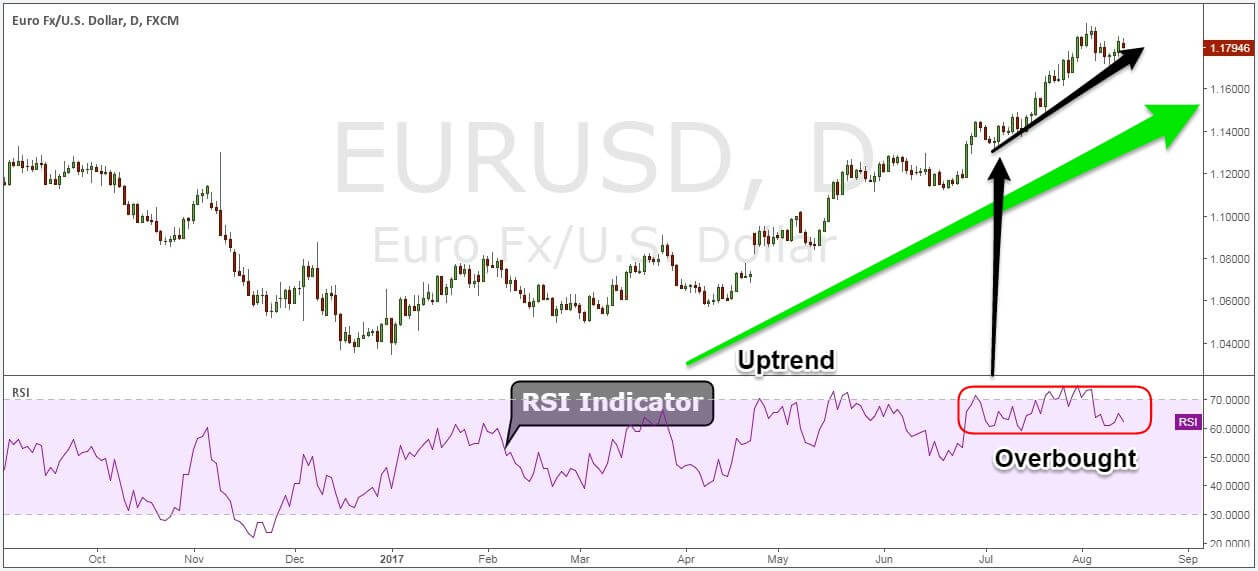
In the example above, we have EUR/USD with the RSI indicator showing an overbought condition in the market. Although the ringgit is excessive, the RSI reading of the EUR/USD continues to rise as the current and dominant trend continues to rise. A novice trader will likely sell as soon as the RSI enters overbought territory, which will cause him to lose money. With experience, traders will learn to time entries and exits with a sense of accuracy.
Note * Technical indicators are not perfect, but if they are used correctly to their strengths and in the context of a trend framework great things can be achieved.
Lagging indicator
Lagging technical indicators, as the name suggests, are delayed from the current market price. Typically, the lag is caused by using larger price data inputs in their calculations. But, lagging indicators can be very helpful in measuring market trends.
The whole idea of using lagging indicators for trend determination is that they remove a lot of the market noise that is inherited in the price and give you a better idea of the trend. But, the downside is that the overtrend indicator will only warn you of a trend after the trend has started.
That’s not great because a lot of times, it means you’ll be late to the party and secondly, then you get into a trend where less margin will be available to you. In this case, by using a lagging indicator to trade, you lose a large part of the potential profit.
The classic moving average crossover system is a good example of how an extreme indicator signals a shift in market sentiment after a new trend has begun (see Forex chart below).
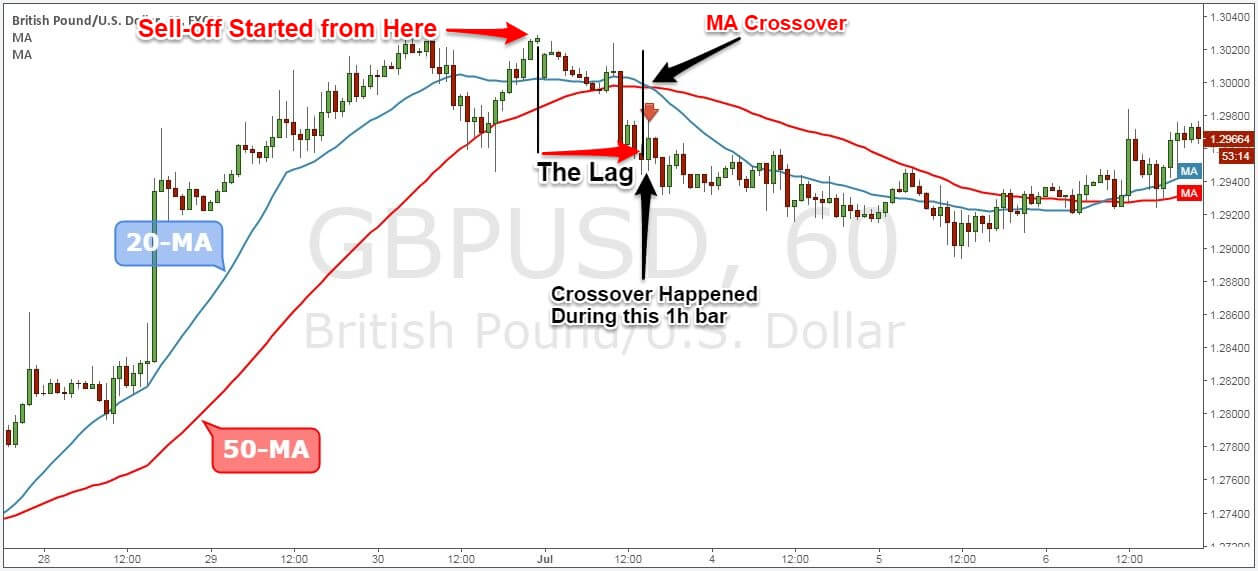
Note * we must remember that the most extreme technical indicators.
Confirming Indications
Confirming technical indicators are very useful for validating your price analysis. As the name suggests, a confirm indicator is only used to confirm that the price action reading is correct. One of the most popular confirmation indicators is On Balance Volume – OBV. The volume indicator is very useful.
The way one would use and interpret an OBV reading is quite simple. What drives the trend of buyers and sellers and their aggressiveness and in this case, the volume should increase when the market moves in an uptrend or in a downtrend.
In the example below, if for whatever reasons, you would conclude that the uptrend will reverse, then by using the OBV indicator, it would confirm your analysis. The uptrend has no momentum because buyers are not buying this uptrend as shown by the OBV indicator.
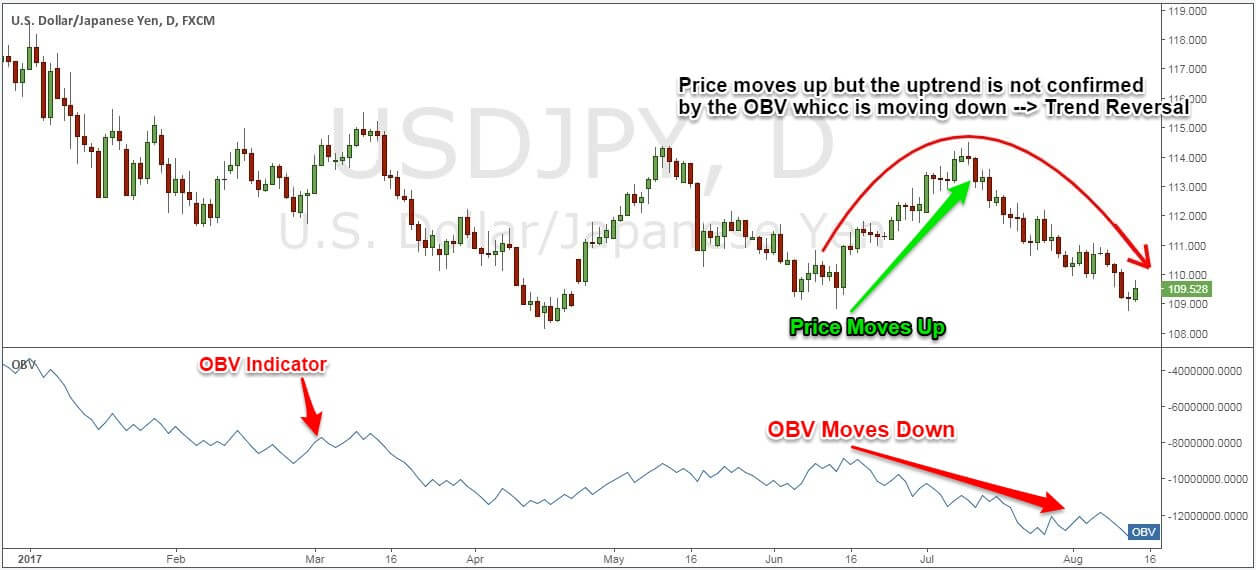
Understanding the differences and similarities between the three types of technical indicators can help you better read the information they provide and then decide how to trade. The best trading indicator for you depends on your trading goals.
In addition, you can also use functional indicators such as, for example, Forex bar time indicators. The candle time indicator only counts the time until the next candle opens. It’s just a functional tool that many professional traders use to measure price charts.
Now, let’s explore the most important Forex indicator of all time.
How to Use Forex Trend Indicators
The 200-day moving average FX trend indicator is considered the best trend indicator out there.
For example, if you look at the 200-day Moving Average. What you will be plotting on your chart is the moving point of the last 200 closing price and then plotting the average price. This way, you can eliminate a lot of the noise that is inherited in your price charts and give you an easier view of what is happening in the market.
Moving averages are an easy way to identify and give some definition to trends. This should give you an answer as to whether you are in an uptrend or in a downtrend and how solid the trend is. Since moving averages can measure the direction of a trend, they are also called trend indicators (see Forex charts below).
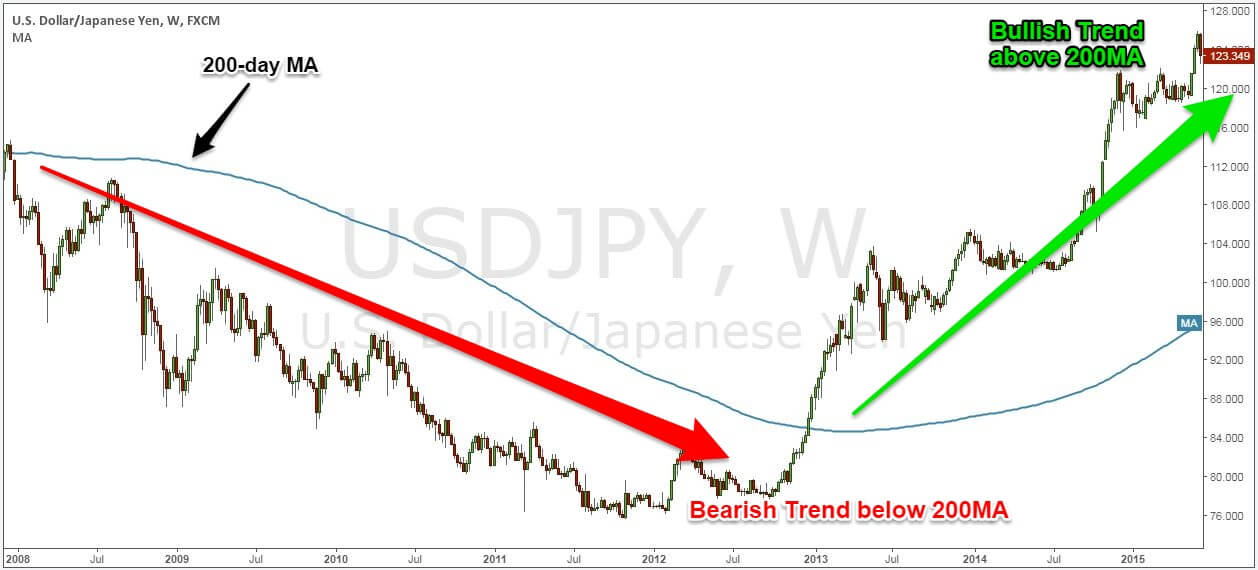
The decline of the moving average and where the price relates to the MA will determine the direction of the trend.
The second most important technical indicator is the Forex volume indicator.
How to Use Forex Best Volume Indicators
The Forex volume indicator is used as a confirmation tool to confirm trends. Moreover, the volume indicator is very versatile which can be used to confirm Forex breakouts. Identifying the damage will allow you to trade in the market.
The volume indicator can help us better understand how healthy and secure the trend is. Volume based indicators will usually be displayed at the bottom of your chart and most come in the form of some type of oscillator. Most oscillators will have upper and lower barriers that will usually signal buying and selling pressure.
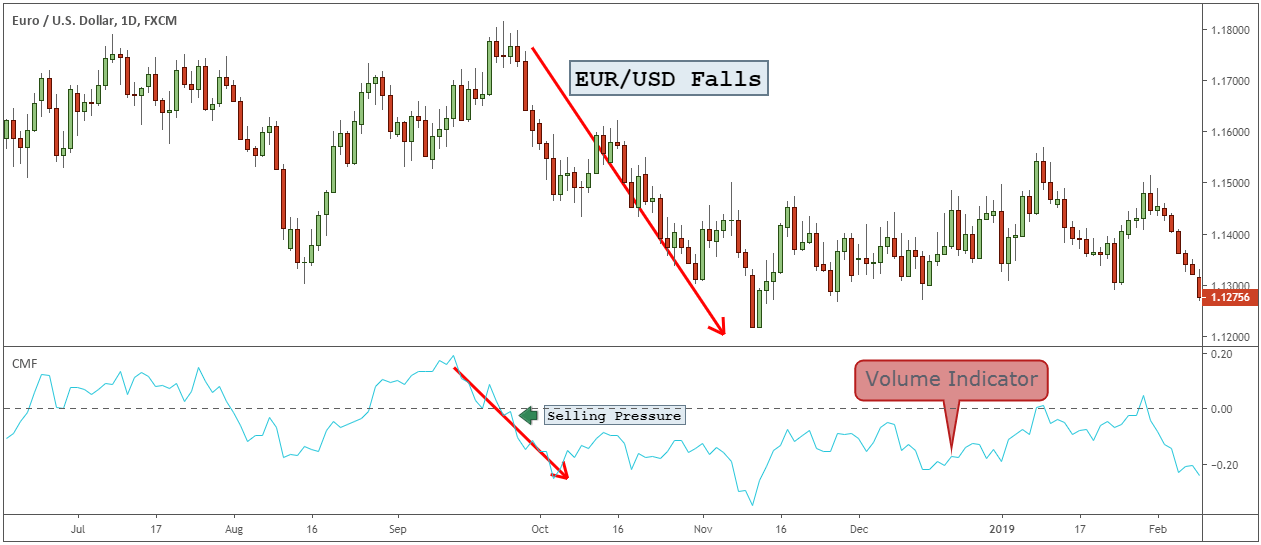
Looking for the best forex volume indicator strategy? Your hunt is over. Check for yourself a FREE Volume Trading Strategy to Win 77% of Trades.
We have also promised that we will show you the Forex navigation strategy indicators that you need to trade by selling Forex.
Forex Breakout Strategy Indicators
How to put the odds in your favor when trading jams?
Breakout is probably the most obvious and common chart pattern. They also create excellent opportunities for profit. Most trends emerge from consolidation releases. The high frequency at which cruise patterns occur makes the escapement easier to give false signals. Using technical indicators to confirm Forex breakouts is essential if you want to distinguish between fake breakouts and real breakouts.
If you want to know how to use the forex breakout strategy indicator, please see some of the best trading tactics used for trading by professional traders: Breakout Trading Strategies Used by Professional Traders.
What makes a violation legal is whether or not the FX run is due to smart money activity. So, to evaluate breakouts, we really need to use volume indicators to measure buying and selling activity by professionals.
One volume-based indicator is the VWMA (Issue Weighted Moving Average).
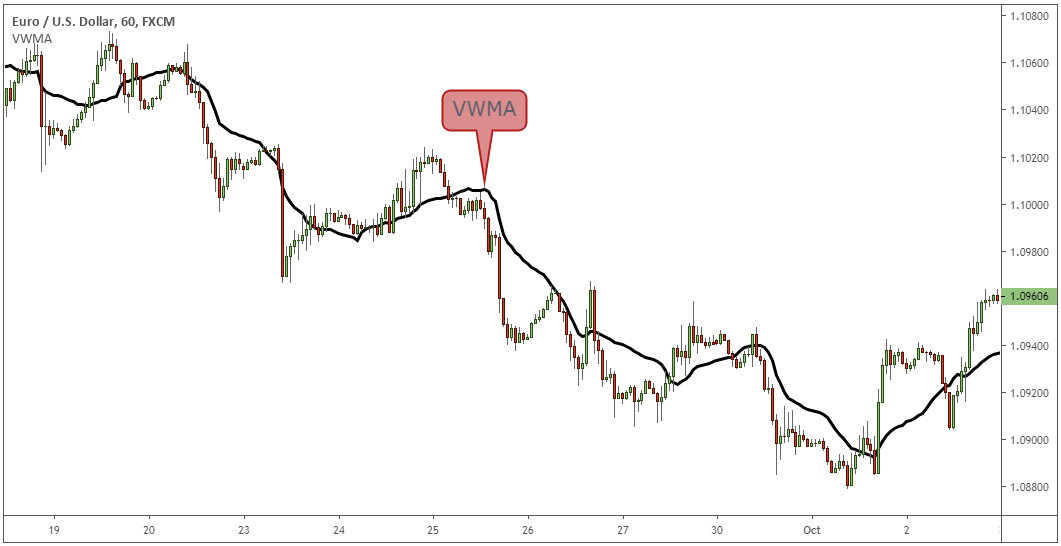
VWMA is one of the most felt technical indicators that only professional traders use. The VWMA looks like a moving average, but instead, it is based on volume. This is not just a price-based move.
Final Word – Forex Directional Indicator
Forex indicators can be very useful if you keep them simple, but they can be a problem if they are too complicated. Make sure you fully understand any forex indicator you choose to use. Certain technical indicators can be very helpful in reading price action and more importantly can help you predict future price movements. However, before venturing into the world of Forex technical indicators, you need to remember that price still remains the primary predictor of the truth about what is actually happening behind any chart.
Each indicator has its own strengths. On the one hand, Forex trend indicators are more useful for determining the general direction of the market. At the same time, some of the best forex volume indicators can be used to confirm the strength of the trend. Read about the best forex strategies here.
Thank you for reading!
Feel free to leave any comments below, we read them and will respond.
Also, please give this strategy 5 stars if you enjoy!







